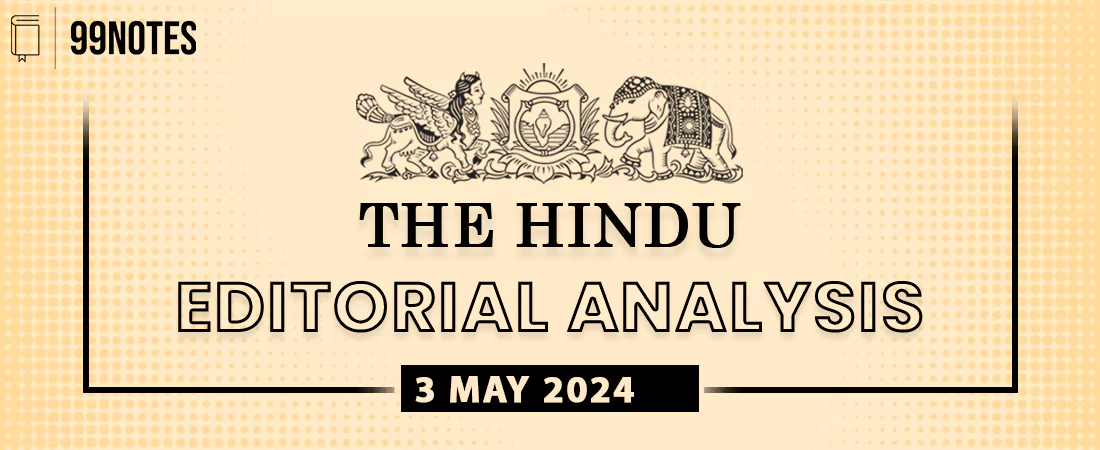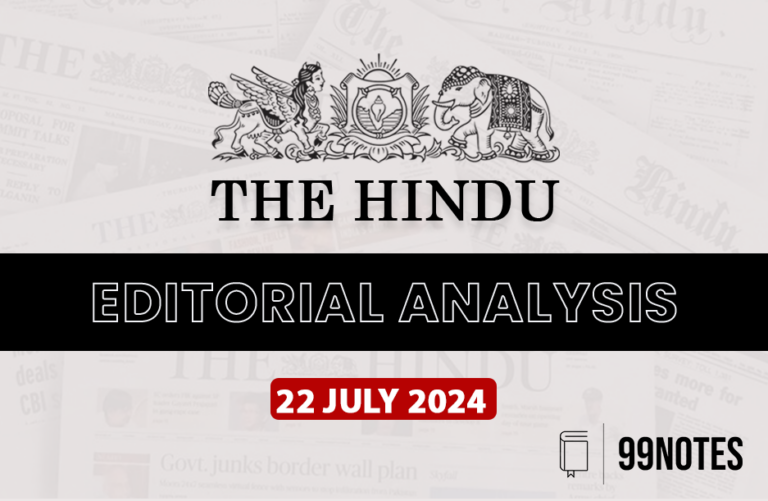3 May 2024 : The Hindu Editorial Notes PDF
1. The judiciary’s shadow over standard essential patents
| Topic: GS2 – Indian Polity – Judiciary
GS3 – Science & Technology – Issues relating to IPR |
| Context |
| ● The article discusses India’s looming crisis surrounding the use of Standard Essential Patents (SEPs) by tech companies against its telecom manufacturing sector.
● It highlights the challenges of SEP licensing, judicial response characterised by lethargy and activism, and the detrimental impact on India’s manufacturing sector. ● Drawing comparisons with Europe, it underscores the urgent need for government intervention to regulate SEPs and protect domestic interests amidst international patent enforcement obligations. |
Introduction to SEP Issue in India
- There’s a potential crisis brewing in India regarding the use of Standard Essential Patents (SEPs) by certain technology companies against the telecom manufacturing sector.
- SEPs are patents covering technologies adopted as industry standards, crucial for interoperability of cellular phones.
- The process of setting standards is privatised and dominated by Standard Setting Organizations (SSOs) largely run by private tech firms, leaving countries like India with little influence.
| Standard Essential Patents (SEPs) |
| ● Standard Essential Patents (SEPs) are patents covering technologies essential for industry standards, ensuring interoperability of products.
● For instance, GSM, CDMA, LTE are such standards in telecom. ● Companies owning SEPs have significant leverage, as manufacturers must licence them to comply with industry standards. |
Challenges with SEP Licensing
- SEP owners gain significant leverage as manufacturers must license these standards to stay competitive.
- This monopoly power often leads to exorbitant royalties, termed as the “patent holdup” problem.
| What is “patent holdup” problem? |
| ● The “patent holdup” problem occurs when owners of Standard Essential Patents (SEPs) exploit their monopolistic position.
● SEP owners demand excessive royalties or favourable licensing terms from manufacturers. ● Manufacturers are compelled to comply to ensure their products adhere to industry standards. ● This monopolistic behaviour stifles competition and innovation. ● It undermines the principle of Fair, Reasonable, and Non-Discriminatory licensing, leading to anti-competitive practices and market distortions. |
- SSOs theoretically require SEP owners to license at Fair, Reasonable, and Non-Discriminatory (FRAND) rates but fail in practice due to opacity and anti-competitive practices.
Judicial Response in India
- Indian judiciary’s response has been marked by both lethargy and activism, particularly at the Delhi High Court.
- The Competition Commission of India’s (CCI) investigation into SEP abuse by Ericsson faced legal challenges, delaying resolution for seven years.
- Meanwhile, the Delhi High Court heard infringement lawsuits against manufacturers, bypassing the resolution of competition law issues.
- The court’s interim remedies, such as requiring manufacturers to deposit money during trials, are unprecedented and detrimental to defendants’ working capital.
Impact on Manufacturing Sector
- Judicial activism combined with delays negatively impacts the government’s efforts to attract investment in manufacturing.
| What does it mean by judicial activism? |
| ● Judicial activism refers to courts actively shaping public policy through their decisions.
● It involves courts interpreting laws broadly to address social and political issues. ● Judicial activism can lead to courts expanding constitutional rights or intervening in legislative matters. ● It’s often seen as a departure from traditional judicial restraint. ● Courts may use activism to fill gaps in legislation or rectify perceived injustices. ● Critics argue it encroaches on the domain of other branches of government. ● Proponents view it as a necessary mechanism to protect individual rights and ensure justice. |
- While the government provides incentives for domestic manufacturing, judicial rulings disproportionately burden manufacturers with hefty deposits.
- Unlike manufacturers creating jobs, SEP owners repatriate profits, hindering India’s economic growth.
Comparison with Europe
- European Parliament enacted regulatory measures to control SEPs, recognizing the need for intervention.
- India’s lack of influence in SEP selection by SSOs and obligation to enforce foreign patents make regulatory measures imperative.
- India’s case for stronger regulatory measures is stronger than Europe’s due to its limited influence in SSOs and international patent enforcement obligations.
Call for Government Intervention
- It’s crucial for the Indian government to intervene and regulate SEPs to protect its manufacturing interests.
- Government intervention is necessary to prevent further damage caused by judicial delays and activism.
- Such measures are vital for India’s economic growth and to ensure a fair playing field for domestic manufacturers.
Conclusion
- India faces a critical challenge regarding SEP abuse, impacting its telecom manufacturing sector.
- Judicial delays and activism exacerbate the problem, necessitating government intervention.
- Regulatory measures similar to those in Europe are crucial to safeguard India’s manufacturing interests and economic growth.
| PYQ: In a globalised world, intellectual property rights assume significance and are a source of litigation. Broadly distinguish between the terms – copyrights, patents and trade secrets. (200 words/12.5m) (UPSC CSE (M) GS-3 2014) |
| Practice Question: Discuss the challenges posed by the use of Standard Essential Patents (SEPs) in India’s telecom manufacturing sector, focusing on the role of judiciary and the need for government intervention. (250 Words /15 marks) |
2. Does PMJAY need a design change?
| Topic: GS2 – Social Justice – Health
GS2 – Governance – Government policies – Issues arising out of their design & implementation |
| Context |
| ● The article delves into the performance and challenges of India’s flagship healthcare program, Ayushman Bharat’s Pradhan Mantri Jan Arogya Yojana (PMJAY).
● Launched in 2018, PMJAY aims to provide health coverage to over 12 crore families from the bottom 40% of the population. ● However, recent reports of hospitals facing financial dues and turning away PMJAY patients raise questions about the scheme’s sustainability and effectiveness, prompting discussions on potential design changes. |
Introduction to PMJAY
- Ayushman Bharat, initiated in 2018, comprises two main components: health and wellness centres and the Pradhan Mantri Jan Arogya Yojana (PMJAY).
- PMJAY’s goal is to provide healthcare coverage of ₹5 lakh per family per year for secondary and tertiary care hospitalisation to over 12 crore families, representing the bottom 40% of the population.
- As of now, PMJAY has issued 34.27 crore cards, facilitated treatment for about 6.5 crore individuals, and enlisted over 30,000 hospitals.
| Ayushman Bharat – Pradhan Mantri Jan Arogya Yojana |
| ● Ayushman Bharat-Pradhan Mantri Jan Arogya Yojana (AB-PMJAY) is the world’s largest health insurance/assurance scheme fully financed by the government.
● Launched in February 2018, it offers a sum insured of Rs. 5 lakh per family for both secondary and tertiary care. ● PMJAY provides cashless and paperless access to services at empaneled hospitals. ● Health Benefit Packages cover surgery, medical and day care treatments, medicines, and diagnostics. ● Packaged rates ensure comprehensive coverage without additional charges to beneficiaries. ● Target beneficiaries are identified based on the latest Socio-Economic Caste Census (SECC) data. ● Once identified, beneficiaries can access services at any empaneled hospital. ● Funding is shared: 60:40 for states and UTs with legislature, 90:10 in Northeast states and specific UTs, and 100% central funding for UTs without legislature. ● The National Health Authority (NHA) is the autonomous entity responsible for PMJAY’s implementation in collaboration with state governments. ● State Health Agencies (SHAs) oversee AB PM-JAY implementation at the state level. |
Discussion on PMJAY’s Design
- Need for Design Change:
- Concerns arise regarding PMJAY’s sustainability, especially as some hospitals in certain states report significant outstanding dues and reduced acceptance of PMJAY patients.
- Key questions emerge regarding the scheme’s effectiveness and the necessity of design modifications to address existing challenges.
- Supply Side Perspective:
- There’s acknowledgment of the importance of allowing patients to access the private sector due to perceived deficiencies in the public sector’s ability to provide universal healthcare.
- However, doubts linger over whether PMJAY was adequately designed to address comprehensive healthcare costs, as it currently represents a minor fraction of total health expenditure.
- Concerns are raised about the potential misallocation of government resources and the emergence of barriers, even within the public sector, which may hinder access to healthcare for low-income families.
- Demand Side Perspective:
- The preference for private hospitals over public ones reflects a perception of better quality care, potentially indicating a need to enhance trust in the public health system.
- Challenges faced by the private sector, such as capacity limitations, delays in claim payments, claim rejections, and capped treatment charges, hinder effective implementation of PMJAY.
Performance Disparity among States
- Varied Performance Metrics:
- Disparities exist among states in terms of hospital activity levels, with some hospitals remaining inactive since empanelment.
- Differences are observed in coverage rates, hospital dispersion, and claim payment delays, necessitating further research to understand underlying factors contributing to performance variations.
- Drivers of Disparities:
- While technological platforms enable claim processing, deficiencies in hospital capacity, particularly in Northern and North-Eastern states, contribute significantly to performance discrepancies.
- Lack of network adequacy requirements for insurers exacerbates challenges, as cards are issued without ensuring accessible healthcare facilities.
Addressing Out-of-Pocket Expenditure
- Need for Holistic Approach:
- While PMJAY aims to mitigate healthcare cost shocks, its current design may not comprehensively cover outpatient care, diagnostics, and drugs.
- Alternative state schemes like those in Tamil Nadu and Rajasthan offer insights into providing some form of universal healthcare, indicating the need for a broader perspective.
- Evaluating the Insurance Model:
- While the insurance model has been instrumental in delivering universal health coverage in several countries, its effectiveness in the Indian context warrants scrutiny.
- Restrictions on insurance to the public sector could potentially enhance performance, especially in poorer states, but broader reforms focusing on payment structures and non-price mechanisms are crucial.
Conclusion
- PMJAY’s effectiveness in achieving universal health coverage hinges on addressing challenges related to hospital capacity, claim processing delays, and disparities among states.
- Enhancing trust in the public health system, reevaluating the insurance model, and adopting a holistic approach to healthcare delivery are essential for achieving sustainable and comprehensive universal health coverage in India.
| Practice Question: Discuss the challenges and potential design changes required for ensuring the sustainability and effectiveness of India’s Ayushman Bharat Pradhan Mantri Jan Arogya Yojana (PMJAY) in achieving universal health coverage. (250 Words /15 marks) |




